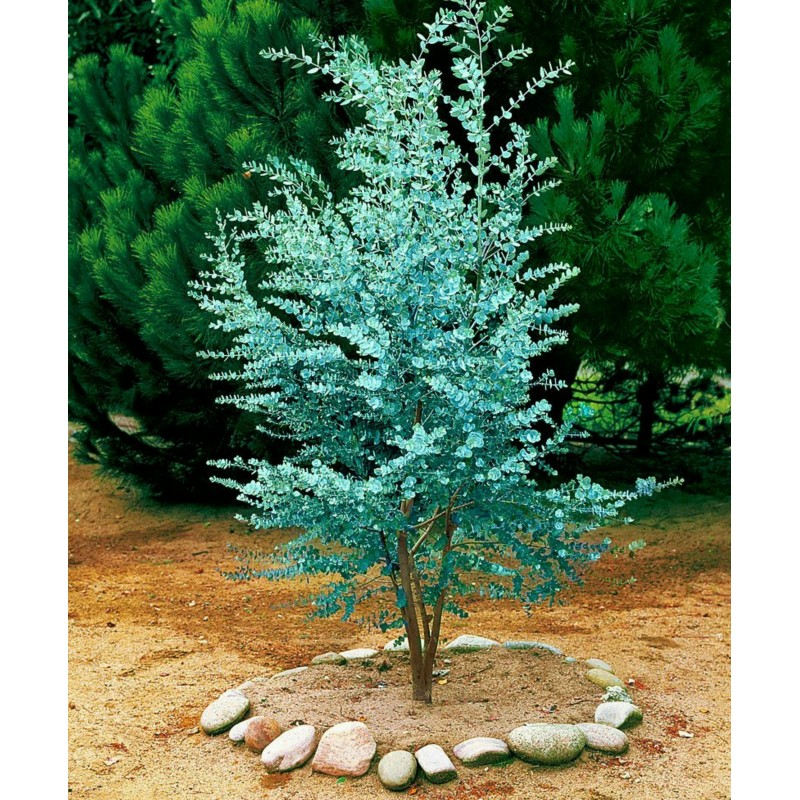
Φυτό ανθεκτικό στο κρύο και τον παγετό








Αειθαλές δένδρο, γρήγορης ανάπτυξης με φύλλα στρογγυλά γλαυκοπράσινα και τελικό ύψος έως 25μ. Είναι ιδιαίτερα ανθεκτικό στο κρύο, στις ξηροθερμικές συνθήκες και την ατμοσφαιρική μόλυνση.
Sowing:
Sowing into containers:
, well drained and sterile compost. (John Innes or 50% multi-purpose and 50% perlite or coarse grit.). Cover with sieved compost or vermiculite. Provide bottom heat if possible. and cover pots with plastic or glass to retain moisture and humidity and protect the seed. Keep moist at all times.
When large enough to handle, transplant/prick out each seedling in its own pot of multi-purpose compost. Seedlings in shallow seed trays need transplanting promptly, handling them carefully by holding the seed leaves, rather than the emerging true adult leaves. Seedlings in root trainers can be left a little longer before transplanting, allowing their roots to fill the module, and then transplanting the whole plug of roots and compost in one go.
Cultivation:
Water regularly, as needed, and feed with liquid fertiliser every month, growing the seedlings on into small plants. The following spring or summer, when the plants are more robust, harden off for 10-14 days before planting out.
Plant them out into the garden in late summer to early autumn, giving them the winter to settle their roots into the soil before coming into active growth the following spring. Best grown in sunny sheltered spots. Cold winds are more injurious than frost.
Planting guide:
Water pot thoroughly and allow to drain. If planting in a lawn, remove a circle of turf 60cm (24in) across. Dig a hole twice the size of the pot and fork over the base, incorporating a handful of general fertiliser and a bucketful of planting compost. Drive in a tree stake a little off-centre. Remove the pot and tease out any matted roots. Position the tree against stake with top of root ball level with surrounding soil. Replace remaining soil, firming-in well. Secure tree to stake with adjustable strap. Water thoroughly, then once a week during the first growing season and during dry spells while the tree is establishing. Garden-grown specimens should not require regular feeding.
Container Specimens:
Grow in any good multi-purpose potting media or soil-based ones such as John Innes No 2 or No 3. Adding up to 30 percent by volume of coarse grit is often helpful. They benefit from monthly feeding with a balanced liquid fertiliser. Keep the compost moist during the growing season and reduce watering in winter. Repot every two years.
Pruning:
Requires minimal pruning if grown as a tree, removing any broken, diseased or crossing branches in late autumn or winter. For the best juvenile foliage, prune in early spring cutting back the stems to two or three buds above the base.
Plant uses:
Containers, Flower Arranging, Architectural, Sub-Tropical, Foliage Specimen.
Other Uses:
When crushed, the leaves produce a scented natural oil which is often used for cleaning and as a natural insecticide. Natural Dyes from the leaves & bark can give pretty colours, usually ranging from tan & yellow through to rust & red. It is also used for producing paper.
Nomenclature:
Eucalyptus (From Greek, meaning "well covered") is a diverse genus of trees (and a few shrubs), the members of which dominate the tree flora of Australia.
There are more than seven hundred species of Eucalyptus, mostly native to Australia, with a very small number found in adjacent parts of New Guinea and Indonesia and one as far north as the Philippines islands.
Flowers: July to October, white to cream, (not often seen in the UK)
Foliage: Fragrant, elliptic, grey-green horizontal branches
Height: 15-20m (15-20ft) if unpruned in 15-20 years. Broadly conical.
Spread: 8-12m (12-15ft) if unpruned in 15-20 years
Soil type: Prefers neutral to slightly acidic soil that doesn't dry out
Position: Full sun to part shade
Χαρακτηριστικά

 Reviews (0)
Reviews (0)